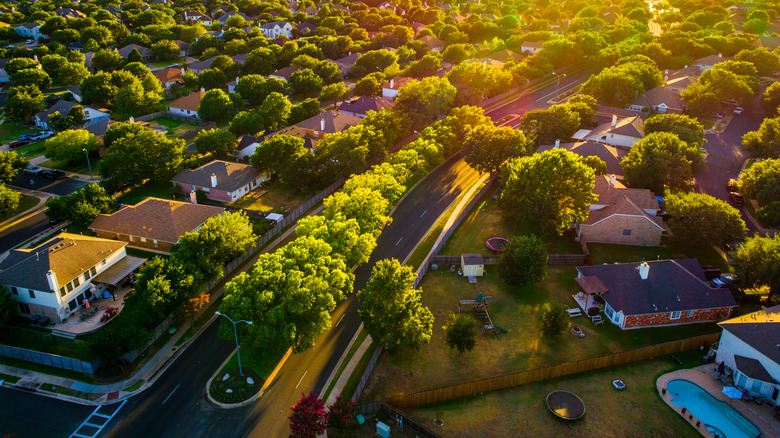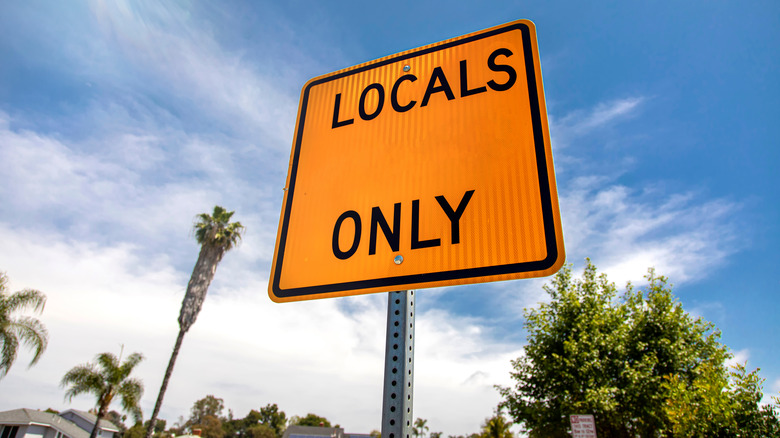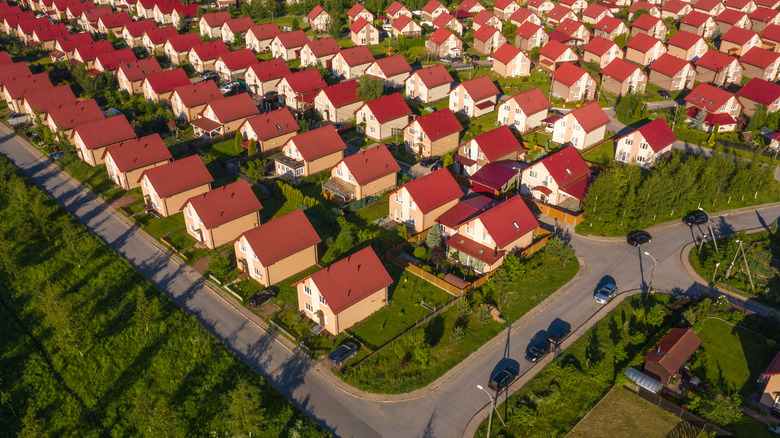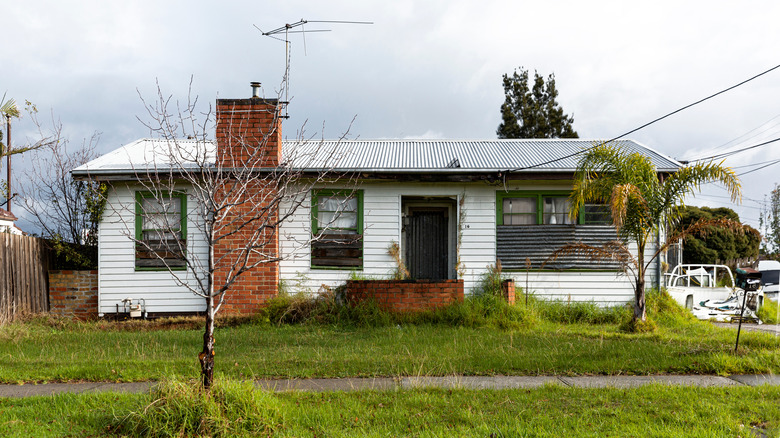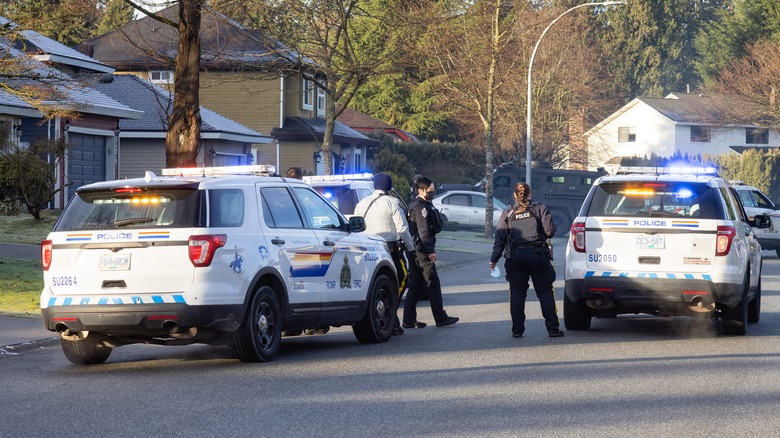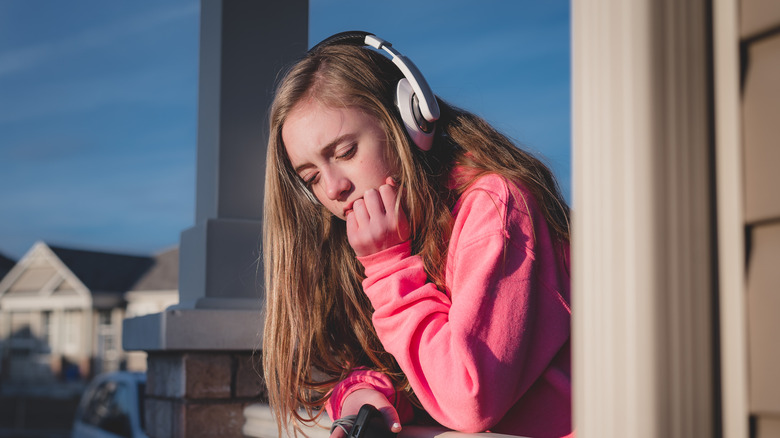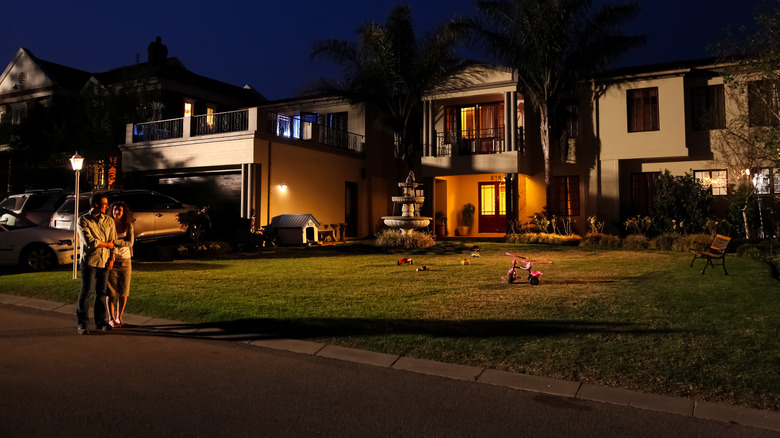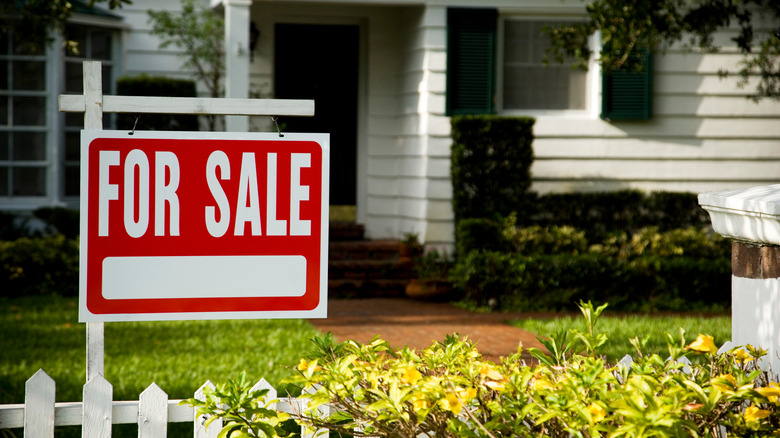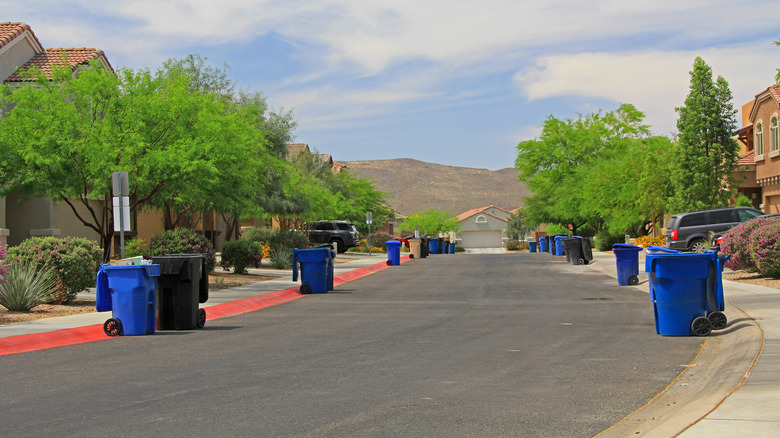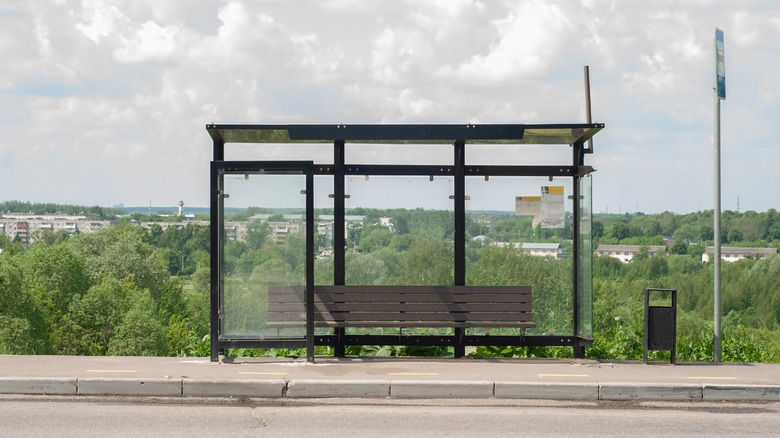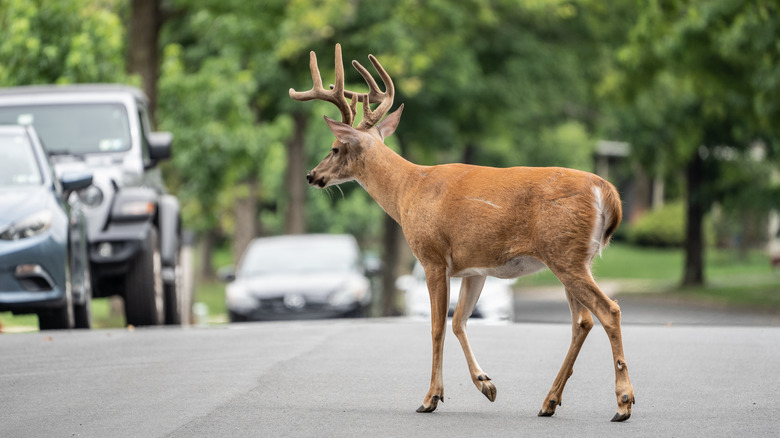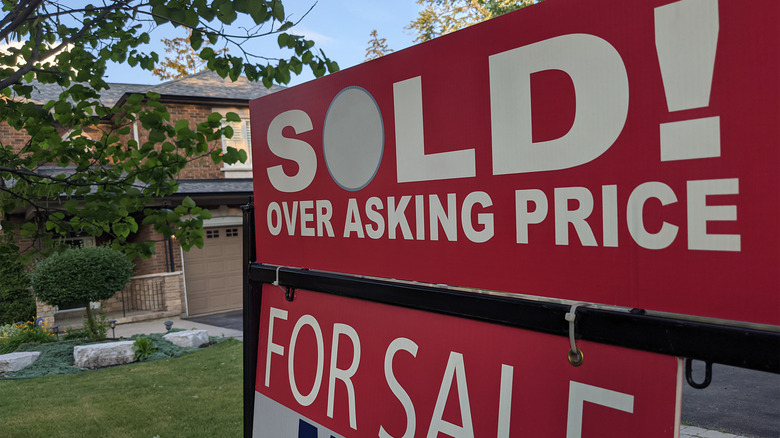The Dark Side Of The American Suburb
The concept of the suburbs — a less-densely populated area outside an urban center — is nothing new. References to suburbs date back to the ancient Egyptians, according to The End of the Suburbs, where the term "suburbani" was used to describe estates outside Rome in the first century B.C. Pretty much as long as there have been big, loud, crowded cities, there have been communities some distance outside the city limits where people went to escape and, supposedly, enjoy a better quality of life.
But the modern American-style suburb as we know it today dates back only to the mid-20th century, when post-World War II prosperity (and the G.I. Bill) made homeownership easy for millions of Americans. The suburbs had always existed, initially as independent villages that were slowly subsumed by growing cities, then as homes for the wealthy seeking to escape the grit and heat of the city. But it wasn't until a confluence of modern technology — roads making it easy to get to and from the cities and assembly line-style home construction that lowered costs in the late 1940s and early 1950s — that America saw its first official suburb: Levittown in Long Island, New York.
Today the suburbs are simply a part of modern life. The suburbs are often seen as safe, quiet places to raise families far away from the pollution, crime, and danger of a city, but they have their disadvantages as well as their advantages.
Racism is baked in
When you think of real estate, you might not immediately think of racism. Houses get built and put up for sale. The suburbs themselves are just property. Except that's never been exactly true because from the very beginning America's suburbs have had racism baked right into their legal documents.
As noted by Untapped New York, Levittown in Long Island is widely considered to be America's first official suburb in the modern sense. Constructed in the late 1940s, Levittown offered affordable but well-appointed houses with very limited options. The houses cost about $8,000, but World War II vets could get one for an eye-popping $400 (approximately $4,500 today), via the magic of the G.I. Bill. There was just one problem: A clause in the original covenant (a legal agreement concerning the use of land) literally required the houses to be sold only to white families (via Untapped New York).
According to NPR, similar racist covenants proliferated throughout the country's suburbs and can still be found in many HOA documents. The Washington Post reports that new laws are being passed that allow current homeowners to have these racist covenants removed at no charge, but the fact remains that the suburbs were clearly conceived as "safe" places where Black people and other minorities would never be found. The consequences of these covenants are still being felt today — the 2017 census estimated the population of Levittown was still just 1.4% Black.
Conformity is the whole point
You don't have to be a tortured teenager to see that the typical American suburb is a shrine to blandness. In contrast to cities and urban centers, which typically developed over long periods of time in unpredictable spurts driven by waves of immigration, economic and political shifts, and architectural movements, most American suburbs look very, very similar.
As reported by Untapped New York, this is partially due to the construction techniques that made the suburbs possible. The first true suburb in the country, Levittown, was built using an assembly line technique where unskilled laborers went from house to house performing specific tasks. The houses were all made from the same materials and featured the same layouts, and construction needs, with only a few variations. This allowed the builders to construct an incredible 30 houses in a single day.
Another reason for the numbing similarity of most suburbs is antiquated rules. Vox reports that the rules governing developments like Levittown, and the suburbs that followed, were developed by the Federal Housing Authority (FHA) in the 1930s. They promoted reliance on cars and made sprawling, empty spaces a necessity, resulting in uniform designs and layouts for most suburban neighborhoods. And as noted by Business Insider, the suburbs also facilitated the rise of Homeowners Associations (HOA), which served to not only keep out undesirable elements (aka, non-white people) but also ensured that the suburbs had a similar look and feel in terms of design, landscaping, and lifestyle.
Poverty is rising in the suburbs
The popular image of the American suburb is one of affluence. Large homes with ample property, big backyards with grass lawns, and plenty of leisure time — the suburbs are often seen as havens for an upper-middle-class lifestyle.
The truth is more complicated. As reported by Pew Research, poverty has grown at a much faster rate in the suburbs than in American cities — a rate of 51% since the year 2000, compared to 31% in urban areas and 23% in rural areas. While the overall poverty rate of urban areas remains slightly higher than in the suburbs, this won't be the case for long if those trends continue. According to Ohio University, the factors driving this shift include the housing crisis, which saw many suburban property owners lose their homes, and rising housing costs as a result of wealthy people moving from the cities to the suburbs. At the same time, the wages paid by jobs located in the suburbs have not increased along with the cost of living there.
Worse, as noted by The Washington Post, the infrastructure of services designed to alleviate poverty and reduce homelessness is still focused almost entirely only urban areas. This includes both federal programs and nonprofit organizations, and their lack of reach into suburban areas leaves many people trapped in cycles of poverty.
Arrest rates are higher in the suburbs
The cliché is that American cities are plagued by crime and violence, while the suburbs — boring as they may be — are safer, the sort of places where kids can ride their bikes at night and people can leave their doors unlocked. Increasingly, however, that isn't the case.
As reported by Bloomberg, the statistics can be misleading because suburban areas are often lumped in with nearby large urban centers. For example, although 78% of arrests in America take place in metropolitan areas, the suburbs actually have the highest arrest rates. In fact, as noted by Axios, in 2016, the arrest rates in suburban areas were higher than in cities with populations over 50,000 for the first time in history.
And higher arrest rates mean that many suburban areas have growing jail populations. As noted by Fast Company, between 2014 and 2015, most urban jail populations shrank significantly, in part because arrests for minor crimes like loitering and vandalism were way down. During the same period, however, arrests for these sorts of minor offenses haven't dropped as rapidly in the suburbs. In fact, jail populations in suburban areas grew by a remarkable 40%.
The suburbs are the epicenter of drug abuse
The abuse of hard drugs like heroin or other opioids has been on the rise. According to the National Institute on Drug Abuse, nearly 1 million Americans older than the age of 12 have used heroin in the past year, and the U.S. Department of Health and Human Services reports that over one million Americans are receiving treatment for opioid addiction.
When we think of illegal drugs and addiction, the lingering clichés are the blighted inner cities, urban areas with crumbling infrastructure, high rates of violent crime, and powerful drug gangs. But that image of drug abuse is outdated — as noted by the National Rehabs Directory, about 75% of America's heroin users live in rural or suburban areas. According to an article published in JAMA Psychiatry, the link between opioids and heroin abuse is pretty clear. A typical story involves someone who becomes addicted to opioids after being prescribed them (for pain management after an injury) and soon discovers that buying prescription pills illegally is extremely expensive compared to purchasing a bag of heroin on the street.
According to Frontiers in Psychology, one of the consequences of this change in the demographics of drug addiction has been an increase in overdoses and deaths, in large part because there are relatively few rehabilitation or treatment options in the suburbs.
If you or anyone you know is struggling with addiction issues, help is available. Visit the Substance Abuse and Mental Health Services Administration website or contact SAMHSA's National Helpline at 1-800-662-HELP (4357).
It traps children in bubbles
There's no doubt that the American suburbs are an isolated lifestyle — as noted by Business Insider, that's entirely the point of your typical suburban design. Houses are surrounded by large lots, set back from the streets, and designed to be accessed directly from your car via a garage or driveway — there's simply no way to easily socialize or meet other people while living in the suburbs.
That's bad enough for adults, but it makes growing up a lot more miserable. The angsty suburban teen raging against the machine is a cliché these days, but there's some truth to it. As reported by Psychology Today, teenagers growing up in the suburbs have higher rates of anxiety, depression, and substance abuse.
As noted by Quartz, one reason for this is how limited a suburban childhood is. Because everything is accessible only by car, kids are totally reliant on their parents to drive them places. There's no easy way for kids to explore their environment because the layout and landscaping of a typical suburban neighborhood inhibit walking. Because the area is typically zoned for residential use only, there's quite literally nowhere to go even if they could walk — only row after row of houses set far back from the street. The suburbs trap kids in bubbles.
If you or someone you know is struggling with mental health, please contact the Crisis Text Line by texting HOME to 741741, call the National Alliance on Mental Illness helpline at 1-800-950-NAMI (6264), or visit the National Institute of Mental Health website.
They're not walkable
Walking is one of the simplest and best exercises you can engage in. It requires no investment, equipment, or skill, but offers improved cardiovascular health, lower weight, and improved muscle tone in addition to a host of other benefits. Walking is also often the easiest and fastest way to accomplish tasks.
But as noted by Business Insider, the American suburbs, by and large, inhibit walking and encourage driving everywhere. As noted by Quartz, suburbs are typically designed to be huge tracts of residential-only and commercial-only zones separated by large empty spaces. There is often literally no place to walk to in an American suburb, and many of these suburban neighborhoods don't even have sidewalks because, according to Popular Science, many suburban residents worry that if you make it easy to walk in their neighborhoods, people who don't belong, will literally walk in.
The design philosophy behind most suburbs leads to some bizarre scenarios, such as a shopping center that a resident can see from their backyard but cannot easily walk to (via Quartz), requiring them to get in their car and drive a circuitous route for access. And this has an impact on safety. According to Slate, studies have shown that suburban areas, lacking sidewalks, make walking much more dangerous than in crowded, traffic-clogged cities.
The suburbs contribute to economic stratification
As noted by Quartz, one of the features of suburban neighborhoods is the derivative design of the homes offered. While this leads to a lot of easy jokes about conformity, it actually has a more subtle and disastrous effect: Because the houses are all essentially the same, they all carry essentially the same value. Since there is usually no way to easily include low-income housing in suburbia due to restrictive zoning, the result is economic stratification. In other words, only people of certain specific affluence can afford to live in the suburbs.
In a more urban area, mixed housing means that wealthy people often live near or among people of much less affluence, creating a healthier society. But according to The New York Times, many people move to the suburbs explicitly to escape such scenarios and fear that adding any sort of affordable housing to their neighborhoods will bring crime and other negative effects. Per Bloomberg, many suburbs (and, to be fair, many cities as well) explicitly forbid the building of accessory dwelling units (ADUs), or "granny flats," which are often seen as solutions for rising housing costs. Even if you have the space on your own property to accommodate them, there is a fear that ADUs will invite an influx of low-income renters. The end result of these policies is suburban neighborhoods almost totally lacking in diversity — economic or otherwise.
The suburbs are filled with wasted space
When people talk about moving to the suburbs, one of the main selling points is usually space: You might be living in a cramped apartment in the city, but in the suburbs, you could afford a whole house with a nice sized yard. As noted by Encyclopedia Britannica, space was one of the driving factors in the rise of suburban neighborhoods. Additionally, the new Interstate Highway System, combined with generous credit, created opportunities to move out to areas that had once been considered remote.
But according to Quartz, it's the way suburban communities are planned that's the problem. Suburban neighborhoods typically include zoning requirements that result in space that is landscaped but not used, including unused space when placing a house unnecessarily far back from the street, the creation of drainage pits, barriers designed simply to stop people from walking, and empty green space that isn't usable for any purpose. The roads in suburbia also tend to be ridiculously wide, in theory, to accommodate large emergency vehicles but in practice to ensure that no one ever has to interact with a neighbor involuntarily.
Those land-use decisions result in sprawl: Low-density residential areas that require more resources to maintain because distance creates inefficiencies.
There's no public transportation
As noted by Quartz, one of the key characteristics of suburban sprawl is a near-total lack of public transit. People living in the suburbs typically have no option to take a bus, train, or light rail. As a result, they are almost completely dependent on automobiles for every single task that takes them from their home — even if they ultimately take a train to work, they usually have to drive to the train station in the first place.
In fact, as reported by Slate, the suburbs are explicitly designed for automobiles, and accessing jobs and resources almost always requires a car. This is especially problematic for the less affluent residents of a suburban community, who find themselves relying on their cars for every aspect of their lives. This makes the price of gas of utmost concern and exposes them to disaster if they wake up one day, and the car won't start.
Americans love their cars, but as explained by How Stuff Works, a robust public transportation system brings a lot of benefits to the communities it serves. For one thing, studies have shown that public transit boosts the local economy. For another, public transit options reduce pollution and lower the environmental impact of large populations. And Encyclopedia Britannica notes that shifting away from cars to public transit also results in fewer accidents and injuries and better air quality.
The suburbs are terrible for the environment
Just about every design decision in the typical American suburb is bad for the environment. As noted by The Conversation, the focus on cars and driving literally everywhere means that suburban areas actually have larger carbon footprints than both denser urban areas and more sparsely populated rural areas. Grist reports that all that empty, wasted space also impacts the environment negatively — denser urban areas like cities have much lower per-person energy use and emission levels.
As noted by Unsustainable Magazine, because the suburbs are located increasingly deep into what was, until very recently, the country (or even wilderness), suburbs are hard on wildlife. They contribute to wildlife fragmentation, wherein animal populations lose access to necessary resources, and septic and sewer systems can undermine the safety of the water and plant life that animals rely on. That impact on water extends to human needs as well — 40% of U.S. water sources are suffering increased levels of pollution, a fact many connect to the steady development of suburban communities.
While mitigating the environmental impact of existing suburban areas would be difficult, we could at least modify the way we design and build new developments by implementing strategies like modular construction, renewable energy sources, and revised zoning limitations designed to increase the energy efficiency and reduce pollution.
They fuel rising home prices
If you've ever dreamed of owning a home but found the prices in your desired area depressingly high, you can partly blame your local suburbs. As explained by CNBC, the reason is simple: the single-family zoning that is found in most suburban developments. Restricting all the housing in a large geographic area means there is no way to introduce more efficient housing options like multi-family dwellings. That drives up the cost of land in general, making it increasingly expensive to buy a home.
In fact, Forbes reports that zoning and other land-use policies play a dominant role in the cost of housing, not the cost of construction, which is relatively cheap. Another factor that contributes to the higher cost of land and thus the higher costs of housing is parking: The more space that's dedicated to free parking for residents, the less space for housing, driving up costs even more.
As noted by Slate, this also impacts the cost of rent. As housing costs rise in the cities due, in part, to the suburbs, people ironically flee to the suburbs for a lower cost of living, but because there are very few rental properties in the suburbs, this drives rents sky-high as a result, which in turn further inflates a property's value. It's a vicious cycle that could be solved with some judicious zoning law revision.
